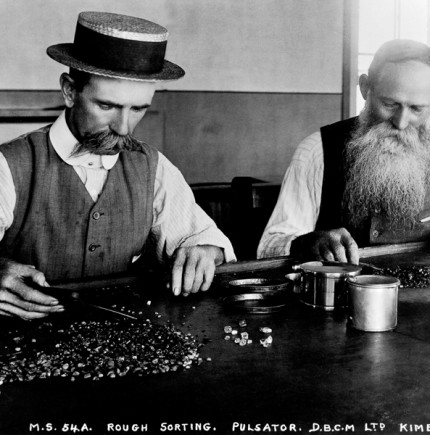
Miner “Always looking”
Russia, Botswana, Canada, Namibia and South Africa are the current frontrunners in producing diamonds. Diamonds are mostly found in volcano pipes, but diamond mining is also possible on the open sea and in rivers. To keep the annual production volume at a certain level, people are always looking for new mines. De Beers is the most famous of all the mining companies, but Dominion Diamond Corporation, Rio Tinto and Alrosa are also regarded as important players.
Sightholder "Take it or leave it"
A sightholder is a trader who is authorized by the biggest diamond mining companies to buy diamonds in bulk. A bulk buy is also called a ‘sight’. Becoming a sightholder is a privilege that is only granted to the most experienced and affluent traders. Mining companies such as De Beers or Alrosa know perfectly well what kind of diamonds the sightholders are selling, so they will adjust their offer accordingly. To refuse or negotiate a ‘sight’ is considered ‘not done’. After purchasing a sight, the sightholders will offer the diamonds to possible buyers or traders.


The Diamond Office has played a crucial part in the success story of the Antwerp diamond trade. It was founded in September 1944, shortly after Antwerp was liberated, to resurrect the diamond industry after WWII. These days, the Diamond Office is responsible for the declaration and expertise concerning the import and export of diamond shipments. Each shipment entering or leaving this country is inspected, verified and cleared by certified experts. Nowhere else in the world are diamond shipments subjected to similar inspections. The Diamond Office handles around 250 million dollars’

A broker is a middleman who receives a parcel of diamonds and then tries to find the right buyer among his contacts at the Diamond Bourse. Brokers are given a certain amount of leeway when it comes to negotiating the asking price. These days, the position of a broker is under pressure because buyers and sellers tend to engage directly with each other more often.
Insurer "Always insured, always safe"
A diamond is always insured: from the moment it leaves the hand of one owner until the new owner claims it. You’ll find specialized insurers in the diamond quarter with an exclusive focus on insuring rough and cut diamonds.
Grader "Every diamond is unique"
Diamond graders evaluate diamonds based on color, weight, clarity and cut. They use specific measuring equipment and software developed in Antwerp. Based on the results of the lab, a certificate is drafted, describing every detail of the stone.
If you want to trade in diamonds in Antwerp, you have to be a registered diamond merchant. Only members of the four events can trade in diamonds in the exhibition halls. There are strict rules to who gets to enter: you have to have two years of experience in the diamond industry, an impeccable personal history, you have to be able to submit certain documents of proof and two existing members of the bourse need to vouch for you.
Membership is similar to having credit: the entire diamond industry knows you can be trusted. If anything goes wrong, you run the risk of worldwide and life-long suspension. The bourse has an internal justice system with a reconciliation committee, that decides the outcome of commercial disputes under the motto “It’s better to have half an egg than an empty shell.” There will always be an internal ruling on disputes before it can move to the Commercial Court. Today, diamond bourses across the world are mostly service-providers.

